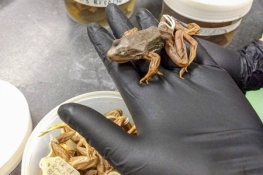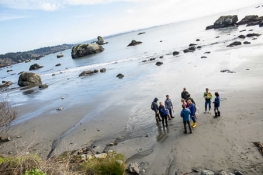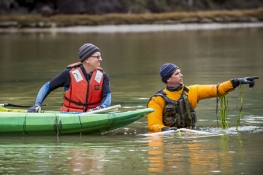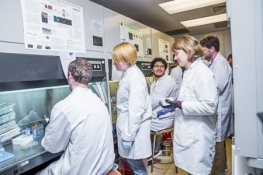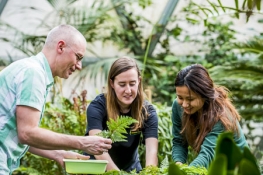Achievements
Publications and achievements submitted by our faculty, staff, and students.
Faculty Oscar M. Vargas-Hernandez Biological Sciences Dr. Oscar Vargas and collaborators have published a new scientific article "Towards a Monophyletic Infrageneric Circumscription of Adesmia DC. (Dalbergieae, Leguminosae): a Taxonomic Revision in Adesmia series Adesmia" in the journal Phytotaxa. https://phytotaxa.mapress.com/pt/article/view/phytotaxa.639.1.1
Submitted: May 8, 2024
Faculty Oscar M. Vargas-Hernandez Biological Sciences NSF has awarded a grant to Dr. Oscar Vargas to study the origin and genetics of rare plants in California. The grant includes funds for supporting a diverse students from participate in the project, and it aims to study four rare plants in the state. https://www.nsf.gov/awardsearch/showAward?AWD_ID=2334849
Submitted: May 8, 2024
Faculty Pedro Peloso, Gisele Santana, Davi Pantoja, Geovania da Silva, Maiume da Silva, Gleomar Maschio (only Peloso is CSU faculty). Biological Sciences Professor Pedro Peloso was a co-author in the paper "Endemic amphibians of the Cerrado and Caatinga: species richness, geographic range and conservation" published in the Herpetological Journal. Their work highlights the distribution and conservation status of all species of amphibians that exist in two major ecoregions in Brazil (Cerrado and Caatinga). Based on geographic distribution data, they recorded 100 species that do not exist anywhere else in the world: 82 from the Cerrado and 18 from the Caatinga. They also discuss the role of formally protected areas in safeguarding threatened species in these ecoregions.
Submitted: April 22, 2024
Faculty Rachael M. Wade Biological Sciences Rachael M. Wade, Assistant Professor of Biological Sciences was awarded a grant for studying ecologically driven morphological plasticity in coralline algae. Her research focuses on the diversity of marine macroalgae and the evolutionary processes that determine and support their current distributions. Macroalgae are often poor dispersers, so understanding how they've diversified and have come to be globally distributed, in some cases. Her work often relies on the incorporation of historical specimens, with genetic resources derived from 19th-century collections, to better understand their diversity and taxonomy.
Submitted: April 14, 2024
Faculty Silvia E Pavan and students Biological Sciences Silvia E Pavan, Assistant Professor of Biological Sciences was awarded a grant for presenting research, with students, at the 2024 Meeting of the American Society of Mammologists. Sylvia is broadly interested in biodiversity, and she works with fieldwork exploration and collections-based research to discover and describe species and to understand species diversity and evolution. Her research has been focused on different groups of mammals, especially marsupials and rodents.
Submitted: April 14, 2024
Faculty Pedro Peloso, Brandice Guerra Biological Sciences Professors Pedro Peloso (Biological Sciences) and Brandice Guerra received a grant from the Maxwell/Hanrahan Foundation (www.maxwell-hanrahan.org) to support an illustration internship at Cal Poly Humboldt. An international student will visit our community this spring to work in a project that aims to raise awareness about amphibian extinctions globally. You can read more about the internship here: https://now.humboldt.edu/news/new-scientific-illustration-internship-gi…
Submitted: March 18, 2024
Faculty Alana Chin Biological Sciences Dr. Alana Chin received a grant to support research looking into factors impacting redwood tree fog-uptake. Redwood trees absorb water from fog, making it a key provider of water in the summer months. However, as the climate changes, so have fog characteristics, increasing the need to understand how redwoods are acclimating to changes in fog. The project will assess and monitor fog absorption capacity in redwoods, and is a critical next step in our ability to predict the impacts of climate change on redwoods and select nursery stock for restoration.
Funding comes from the Save the Redwoods League.
Submitted: March 8, 2024
Student Range Plant Identification team Biological Sciences Cal Poly Humboldt’s Range Plant Identification team placed 5th in a contest during the Society for Range Management Meetings in Sparks, Nevada on January 30. Coached by lecturer/NRCS Rangeland Specialist Todd Golder, team members include: JJ Madrigal Garcia, Celeste Orrick, Jennifer Salguero, Mikhela Aiken, Logan Holey, Forrest Horrobin, Hunter Mortensen, SRM President Barry Perryman. Students practice plant identification skills in RRS 475 Advanced Study of Range Plants. Most plant species on this test were grasses and many consisted of mere fragments of material. The team owes much to Humboldt’s excellent Range and Botany courses.
Submitted: February 13, 2024
Faculty Silvia Pavan, Pedro Peloso Biological Sciences We just published a paper on diversity of non-volant small mammals (marsupials and rodents) from Parque Nacional del Río Abiseo (PNRA), a poorly known site located in the eastern Andean slopes in Peru. We report the highest ever recorded diversity for high Andes, and through DNA barcoding we reveal several putative new species of small mammals that are uniquely known form PNRA. The paper is a result of an expedition in 2018, funded by National Geographic, and had the collaboration of a diverse team of researchers including myself as first author and Cal Poly colleague Pedro Peloso as senior author.
Submitted: February 12, 2024
Faculty Brian Tissot, Sean Craig Biological Sciences Drs. Brian Tissot and Sean Craig received funding to continue ongoing monitoring research in Marine Protected Areas (MPAs) along the California coastline. MPAs are regions designated and managed for the long-term conservation of marine resources, ecosystems services, or cultural heritage. Specifically, he and his team are looking at underwater kelp forests, collecting ecological and environmental data that will inform the evaluation and adaptive management of California’s network of MPAs. The project includes collaborators from UC Santa Cruz, UC Santa Barbara, and Occidental College. Funding comes as a subaward from UC Santa Cruz, with the primary funder being California Sea Grant.
Submitted: September 27, 2023
Faculty Dr. Oscar Vargas Biological Sciences Dr. Oscar Vargas collaborated in the assemblage and annotation of a spiral ginger genome. Authors sequenced the nuclear genome of two species of plants in the family Costaceae. The study provides a draft annotation for the genome by mapping the transcriptome (RNA, expressed DNA) of one species to its draft genome. This study provides useful genetic resources for the study of non-model organisms. https://doi.org/10.1093/jhered/esad018
Submitted: April 18, 2023
Faculty Dr. Oscar Vargas Biological Sciences Dr. Oscar Vargas collaborated in the description of a new species of spiral gingers from the mountains of Costa Rica. The paper examines the possible causes of speciation by comparing the genetics and climate preference of the new species to its closest relative. https://doi.org/10.1600/036364423X16758877666039
Submitted: April 18, 2023
Faculty Silvia Pavan Biological Sciences Dr. Silvia Pavan received a grant from the National Science Foundation to implement a project that will digitize and georeference Cal Poly Humboldt’s mammal collection. The project will be part of a collaborative effort under the Ranges Thematic Collections Network (Ranges TCN), an initiative lead by the University of North Carolina, to digitize and mobilize trait data from mammalian museum specimens from across the American West, including standard external morphological measurements, reproductive and life history observations, and information on ecological associations. Resulting trait datasets will support next-generation anatomical and evolutionary research, and provide baselines for future population monitoring efforts.
Submitted: February 2, 2023
Faculty Erik S. Jules Biological Sciences Erik Jules (Biological Sciences) published a paper with ten Humboldt student co-authors in the American Journal of Botany (doi.org/10.1002/ajb2.16112). The study -- titled "Genotype accounts for intraspecific variation in the timing and duration of life cycle events" -- was an experimental study of willows covering an area approximately the size of a football field. The results showed that the timing of key life events, such as leaf emergence, flowering, and fruit set, are all heritable traits, indicating that natural selection could favor some individuals under changing climate conditions. Of the ten students, six went onto graduate school after leaving Humboldt.
Submitted: February 1, 2023
Faculty Pedro Peloso Biological Sciences Research Associate Dr. Pedro Peloso and collaborators have discovered and described a new species of frog from South America (Brazil and French Guiana). They revealed this discovery in a paper titled "A new Chiasmocleis (Anura: Microhylidae) from the eastern Guiana Shield with an amended definition of C. haddadi", published in the Journal Zootaxa.
Submitted: November 8, 2022
Faculty Dr. Oscar M. Vargas-Hernandez Biological Sciences Assistant Professor Dr. Oscar Vargas and collaborators published a paper titled "Evolutionary history constrains heat tolerance of native and exotic tropical Zingiberales." The paper studies the thermal tolerance of native and wild gingers in Costa Rica, discussing its implications to conservation and the biology of invasive species.
Submitted: November 4, 2022
Faculty Pedro Peloso and Brandice Guerra Biological Sciences Dr. Pedro Peloso and Brandice Guerra, M.F.A., received a $10,000 grant from the Maxwell/Hanrahan Foundation to support a scientific illustration residency program at Cal Poly Humboldt. The program will recruit a student or recent graduate from anywhere in the world to work with faculty from the departments of Art+Film and Biology. The intern will create a series of illustrations of recently extinct Brazilian frogs, and share their work and artistic process through a lecture or exhibition on campus.
Submitted: October 24, 2022
Staff Matthew D Johnson, Amy Sprowles, Steven Margel, Kat Goldenberg, Raven Palomera Biological Sciences Matt Johnson, Amy Sprowles, Steven Margell, Kat Goldenberg, and Raven Palomera recently published a paper entitled, “Impact of a first‑year place‑based learning community on STEM students’ academic achievement in their second, third, and fourth years” in the journal Innovative Higher Education. The paper reports the effects of the first three cohorts of the Klamath Connection PBLC made possible by contributions from all across the university and funding from the campus’s HSI STEM grant from the US Dept of Education.
Submitted: August 22, 2022
Student Melody Tew, Nicole Rahman-Garnier, Jordyn Neal Biological Sciences Several Cal Poly Humboldt students were recognized at the annual conference for the American Society of Ichthyologists & Herpetologists.
Biology Graduate Student Melody Tew received the Raney and Hubbs awards and presented her research on the developmental origins of White Sturgeon scales.
Biology Graduate Student Nicole Rahman-Garnier received the Cashner and Raney awards and presented her research on the olfactory (scent-sensing) anatomy of local Rainbow Trout.
Recent Marine Biology graduate Jordyn Neal received the Clark Hubbs award and presented her research on the comparative anatomy of the skulls and inner ears of sharks, using high-resolution CT scanning.
Submitted: August 5, 2022
Student Club Hannah Cornwell (the PreMed Society student President) Biological Sciences PreMed and PreVet Society students organized an event called Intro To Suturing Workshop on April 25. They invited Dr. Bret Gorham from Providence St. Joseph Hospital and Dr. Ellie Carrier from North Coast Veterinary Hospital. The workshop lasted 2 hours long (much longer than the scheduled one hour) and provided hands-on training to ~25 students on suturing skills. The workshop encourages interest in pursuing healthcare careers.
Submitted: April 30, 2022



